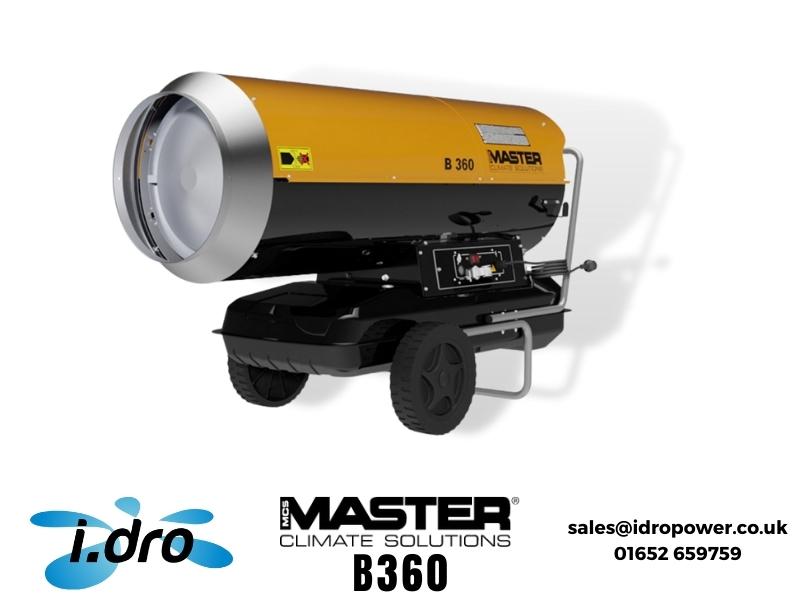
B360 (Master)
The B360 is the big boy of Master’s direct, diesel-powered heater range. The B360 is designed for open and semi-open spaces, where keeping the cold out is impossible. For example, sheds and warehouses with big open doors and building sites are the environments in which the B360 thrives.
Feeling hot hot hot
The advantage of direct heat generation for open and semi-open environments is the sheer efficiency and volume at which they operate. So long as the space is well-ventilated (which open and semi-open spaces tend to be), direct heating does not separate combustion and heat production. This means no heat is lost when trying to separate exhaust and heat. Plus, it means the heat is easy to expulse into the workspace. The result, therefore, is 3’300m3 of heated air being produced an hour.
Right where you need it
The B360 might be the biggest of the range, but they’re still mobile. Mounted on a sturdy chassis and frame, boasting chunky wheels and handles, the B360 is still easy to position where you need them.
Easy to use
After you’ve got your B360 right where you need it, using it is as simple as turning it on. Available with either an analogue or digital thermostat: set it to your desired temperature and let the heater do the rest. If the temperature drops too low the heater will strike into action. Once back up to the desired temperature, the heater will go into standby.
3 reasons why you should get a Master B model?
- They are simple to use, with no-nonsense controls.
- They throw out incredible amounts of heat.
- They are incredibly portable.
Bonus reason: they look like jet engines.
Direct vs Indirect Heating
The difference between direct and indirect heaters is simply how these heaters expel heat. The way to think about a direct and indirect heater, therefore, could be the distinction between an open and closed fireplace. A direct heater is similar to the open fireplace and the indirect heater is similar to the stove.
Why is the direct heater similar to an open fireplace?
The direct heater is similar to the open fireplace as it expels heat by throwing out the air that it uses as part of the combustion process. Of course, in a direct heater, the combustion process is cleaner and better protected than in an open fire.
The positives of direct heating are that the heat efficiency is as high as it possibly can be. Less energy is lost as the heat does not have to be transferred. Therefore, the temperature and rate of heat expulsion can be much higher for a direct heater than for an indirect one. The higher efficiency often leads to greater airflow too, meaning the hot air can be thrown quicker and further into an open space.
The negative of direct heating is that the hot air from the heater is essentially the exhaust of the heater. Direct heaters, therefore, are only to be used in well-ventilated spaces.
Specification Table
Mobile phone users: our tables can be easier to read in landscape.
| Specifications | Units | B180 | B230 | B360 | ||||
| Heating Power | kW | 48 | 65 | 111 | ||||
| Air Flow | m2/h | 1550 | 3000 | 3300 | ||||
| Fuel Autonomy | h | 8 | 10 | 10 | ||||
| Thermostat | Analogue or digital | |||||||
| Fuel consumption | l/h | 4.5 | 6.2 | 10.6 | ||||
| Power supply | V/Hz | 220-240/1ph/50 | 220-240/1ph/50-60 | |||||
| Electric power | kW | 0.3 | 0.8 | 1.06 | ||||
| Rated current | A | 1.5 | 3.5 | 4.6 | ||||
| Protection | IP44 | |||||||
| Tank capacity | l | 36 | 65 | 105 | ||||
| Product size (L x W x H) | mm | 1165 x 380 x 550 | 1235 x 575 x 790 | 1600 x 700 x 940 | ||||
| Box size (L x W x H) | mm | 1200 x 400 x 530 | 1200 x 650 x 1000 | 1600 x 750 x 1180 | ||||
| Net/gross weight | kg | 30/34 | 57/72 | 84/105 | ||||
| Pallet | 8 | 1 | 1 | |||||


